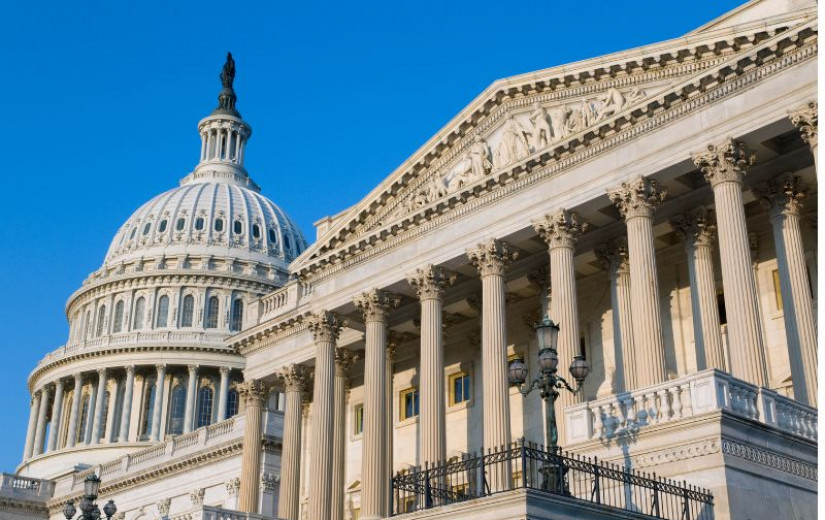
May Day 2025 in the United States came amid the most aggressive assault on U.S. workers in a century. The federal agencies that provide some minimal protection against corporate power — the National Labor Relations Board (NLRB), the Environmental Protection Agency (EPA), and many more — are being systematically destroyed. On May 1, hundreds of thousands protested at roughly 1,300 actions across the United States. Under the broad theme “Workers Over Billionaires,” they condemned union-busting, austerity, climate destruction, anti-immigrant terror, the U.S.-Israeli genocide, and other facets of the assault.
Protests like these are important, but will have little impact on their own. Stopping the billionaires will require much more.
To protect the NLRB, EPA, and other agencies, we must consider what allowed for those agencies in the first place. From a historical perspective, what’s surprising isn’t so much the current blitzkrieg as the fact that agencies that help protect people and environment were tolerated for so long despite business opposition to them.
Regulatory agencies ultimately stabilize capitalism, but they are usually met with either hostility or grudging support from capital. As many observers have remarked, an unrestrained capitalist class will tend to undermine its own long-term stability by devouring the workers and natural resources that make profits possible. It will also block the government reforms that could save capitalists from themselves.
The history of the NLRB is a stark example. Created in 1935 under the National Labor Relations Act (“Wagner Act”), the board furnished a legal framework for unionization and collective bargaining by private sector workers. Whatever their moral commitments, New Deal Democrats were also driven by the need to channel worker rebellion into bureaucratic channels and thereby restore stability to a class system under threat from below. The act tellingly included new legal restrictions on union activities.
Capitalists only accepted the NLRB reluctantly. They soon tried to handcuff it, most notably with the 1947 Taft-Hartley Act that drastically curtailed workers’ rights to unionize, strike, boycott and join anti-capitalist political parties. Most of Taft-Hartley remains on the books today.
That the NLRB has survived at all reflects the lingering imprint of past worker insurgency. For nine decades, most corporate leaders and state elites have seen the NLRB as preferable to the unknown chaos of dismantling it, especially since they were able to clip its wings.
But as the labor upsurge that spurred the NLRB’s creation receded into the past, and new upsurges were less frequent and disruptive, much of the ruling class came to question the need for the board at all. Now that President Donald Trump and Elon Musk are intent on returning workers to the Gilded Age, fellow capitalists long ambivalent about the NLRB may not object to a coup de grâce. They definitely won’t object if Trump and Musk choose the lesser option of further neutralizing the agency through defunding, hamstringing and pro-business appointments.
Either way it’s a good moment to revisit the agency’s birth. Defending the NLRB, let alone winning something better, requires understanding the historical conditions and organizing strategies that made its creation possible. Until the labor movement again becomes a real threat to capitalists, workers’ legal rights will continue to be eroded.
Union Recognition Before 1935
The industrial unions that formed in the late 1800s and early 1900s were violently crushed in the aftermath of World War I. By the 1920s only about 10 percent of United States workers were unionized.
The courts and laws of the pre-NLRB era were generally unequivocal enemies of labor. In 1842 the Supreme Judicial Court in Massachusetts ruled that workers, not employers, were responsible for dangerous workplace conditions. In 1857, the Supreme Court upheld slavery for Black people. In 1905, it declared that laws limiting work hours were unconstitutional. In rulings between 1917 and 1922, it gave its blessing to the anti-union pledges that employers forced on workers and to bans on mass picketing, sympathy strikes and secondary boycotts. Judges readily granted injunctions to employers who faced strikes, based on the many local, state and federal laws that prohibited and harshly penalized work stoppages. This meant that by the 1920s, most strikes were effectively illegal. Meanwhile, the bosses were usually free to fire and even kill disobedient workers, since murders often went unpunished.
For workers to wield real power, they can’t rely on lobbying, elections and NLRB complaints.
Still, workers did achieve some notable victories, almost always as a result of strikes and strike threats. Several years before muckraking journalist Upton Sinclair published his meatpacking exposé The Jungle, Chicago’s slaughterhouse workers had won a 10-hour day by using work stoppages that created what an industry journal described as “a state of siege.”
Later, fears of disruption to wartime production, and thousands of actual strikes, led to widespread adoption of the eight-hour day. Over 1 million workers won the eight-hour day from their employers between 1915 and 1917. Only in the second half of 1918 did the National War Labor Board, which had been established to manage wartime labor relations, move to extend the eight-hour limit across industry.
A rare legislative advance was a 1916 federal law granting railroad workers the eight-hour day. Congress passed it one day before railway unions had threatened to go on strike. The railroad owners only accepted it in 1917 when workers again threatened a national strike.
Transit and logistics workers were also crucial in forcing some employers to grant de facto union recognition. In 1919, illegal picketing by Seattle’s longshore workers won them union control over hiring. Especially significant were the battles of the Amalgamated Association of Street and Electric Railway Employees of America, founded in 1892. An 1898 federal law urging employers to agree to “voluntary arbitration” went ignored. By waging over 200 strikes — with scores of workers killed — union members forced the streetcar companies to agree to arbitration. By 1915, the national union had secured over 200 collective bargaining agreements.
The Amalgamated’s exercise of workplace power contributed to victories for the entire working class. The union’s successful battles for arbitration provided a model that states and later the federal government used to end industrial conflict. Its fight for safer streetcars also established precedents for later court rulings on workplace safety.
“The Industrial War” in the 1930s
In 1937, Fortune magazine remarked that the recent “assistance rendered by the government” to workers “is itself symptomatic of a real pressure” external to the government. “Washington has strengthened labor’s position, not just for the hell of it, but in response to forces that the depression stimulated and revitalized.”
One of those forces was the economic crisis itself, which market-based approaches between 1929 and 1935 had failed to end. The other force was the title of the article: “The Industrial War.” As profits soared to new levels, workers grew less compliant. Some 5.6 million went on strike between 1933 and 1937.
In June 1933, President Franklin Delano Roosevelt had signed the National Industrial Recovery Act, Section 7(a) of which affirmed workers’ right “to organize and bargain collectively through representatives of their own choosing.” Section 7(a), and the unionizing and strikes that followed, are often cited as evidence that labor-friendly Democrats catalyzed the labor movement’s growth.
This argument misses the deeper causes of labor’s advance. Communists and other radicals provided the early organizing muscle in the key mass production industries. They consciously targeted the most strategic sectors of the economy, starting with coal.
Between 1928 and early 1933, the communist-led and interracial National Miners Union (NMU) had organized coal workers from western Pennsylvania to Alabama. They carried out mass strikes peaking in 1932.
John L. Lewis, president of the United Mine Workers of America (UMWA), took action to counter the communists’ rising influence. In February 1933, he pressed Congress “to foster collective bargaining as a means of combating Communism,” writes historian Irving Bernstein. The UMWA was the crucial “impetus” for the inclusion of Section 7(a) in the June 1933 law, Bernstein notes. Without the communists, Section 7(a) might never have been included.
The UMWA also benefited directly from the communists’ work since coal companies saw the UMWA as a lesser evil. After suffering major losses in the 1920s, the UMWA soon received thousands of new members.
Other unions benefited indirectly. The UMWA’s new dues-paying members delivered revenue that Lewis soon reinvested into union organizing in the auto, steel, electronics and meatpacking industries, where communists were again often the key organizers.
The next turning point came in 1934. Sen. Robert Wagner’s proposed bill went nowhere when he introduced it in March 1934. A year later, a similar version passed both houses with overwhelming support.
The decisive shift from 1934 to 1935 didn’t come from above. As of early 1935, President Roosevelt and Labor Secretary Frances Perkins hadn’t “lifted a finger” in support of union rights, as Perkins herself admitted. What made the difference were the 1,856 strikes by almost 1.5 million workers during 1934, including three massive radical-led strikes in San Francisco, Minneapolis and Toledo.
By February 1935, Wagner’s bill, and its House counterpart from Rep. William Connery, appeared preferable to continued bedlam. Most of Congress agreed with Representative Connery’s argument that reform was necessary to keep “the gates of hell” from bursting wide open, and “to save those corporations from communism” by facilitating unionization. President Roosevelt signed the new law in July.
Over the next 12 years, unions would gain 12 million new members. It didn’t happen automatically though. Even after Roosevelt signed the law, most employers ignored it. Only after another round of shopfloor upheaval would they allow it to be enforced.
“Another Means of Defense”
The most decisive confrontation were the sit-down strikes at General Motors (GM) factories between December 30, 1936, and February 11, 1937. GM’s profits had risen from $8 million to $240 million in the prior four years, thanks largely to speedup of the assembly line and the poverty wages of GM workers. In 1936, the United Auto Workers (UAW) began organizing workers in Flint, Michigan, supported by reinvested UMWA dues.
Workers strategically shut down two “mother plants,” preventing around 10,000 cars a day from being produced. Fifteen additional plants went on strike and many more stopped production due to the supply chain disruption. Business Week grudgingly noted that organizers had “skillfully picked out the bottle-necks of production and choked them off.”
The sit-downs were widely seen as illegal. Judges issued two legal injunctions at GM’s request, ordering workers to vacate the plants or face harsh legal penalties. The workers defied them. On February 11, GM finally surrendered, recognizing the UAW for six months during which time the union signed up tens of thousands of members.
U.S. Steel then quickly recognized its own union to prevent a similarly debilitating strike. Two of the three biggest corporations in the country, both notoriously anti-union, had conceded.
That’s especially remarkable given that the Supreme Court was widely expected to rule the Wagner Act unconstitutional that spring. It might have done so if not for the auto and steel victories and the prospect of continued industrial strife. Had it overturned Wagner, wrote Fortune that November, “the labor situation in the US might swiftly have become blood and chaos.” The court’s April 1937 ruling stated that unionization “is often an essential condition of industrial peace.”
Labor’s occasional breakthroughs since the 1930s have usually resulted from 1930s-style militancy, most of it illegal.
GM granted more definitive union recognition in 1940 after factional rivalries within the UAW had further destabilized its factories. The factions were conducting alternating work stoppages to win workers’ support.
Other industries complained of similar chaos. Business Week reported in 1938 that companies were now “look[ing] to the government for help” by calling upon the NLRB to conduct orderly elections. It was the bosses’ invitation that finally empowered the NLRB.
Meatpacking too was notable for “workers’ reliance on direct action to bring their employers to terms,” writes scholar Rick Halpern in his valuable study Down on the Killing Floor. “Strategically situated killing-floor workers” exploited chokepoints in the production process. The Packinghouse Workers Organizing Committee secured its first NLRB election in 1937 by shutting down the floor at key nodes and using the threat of meat spoilage.
In some packinghouses workers were so well organized that they refused employers’ pleas to let the NLRB adjudicate disputes. “You’re looking at the Labor Board in this plant right now,” they told the boss in one confrontation. Black communist organizer Hank Johnson said that the workers “have another means of defense equal to the service being given by the NLRB.” The union’s remarkable degree of interracial solidarity bolstered that defensive capacity.
Forgetting the “Other Means”
Lured by the promise of NLRB assistance, and threatened by legal repression, most unions quickly abandoned the militancy that had allowed for their growth. They turned instead to litigation, lobbying and electoral campaigns while purging radicals. Employers meanwhile went back on the offensive, securing the 1947 Taft-Hartley Act and many later restrictions.
President Harry Truman promised to repeal Taft-Hartley if elected in 1948. He neither fulfilled that promise nor any of his other progressive campaign pledges. When employers blocked repeal, union leaders vowed to campaign against anti-labor members of Congress “with all our energies.” The pitiful result was a Republican trifecta in 1952 and the NLRB’s further lurch to the right.
Almost every Democratic president from Truman to Joe Biden has promised legislation to limit employers’ union-busting activity. Each time employers lobbied hard in opposition, and the Democratic president didn’t really put up a fight. The defeat of labor law reform under President Jimmy Carter ushered in “a far more open employer opposition to unionization and collective bargaining,” writes leading NLRB historian James Gross.
Yet through it all, most U.S. unions have continued to prioritize bureaucratic channels. They have failed to absorb the lesson that Business Week hinted at in 1976: Business enjoys “direct access to the highest levels of the federal government,” while labor does not. For workers to wield real power, they can’t rely on lobbying, elections and NLRB complaints that take years to resolve and at best levy small penalties on employers.
Labor’s occasional breakthroughs since the 1930s have usually resulted from 1930s-style militancy, most of it illegal. Workplace health and safety laws would be weaker or nonexistent if not for wildcat strikes by coal miners. Federal workplace and other disability protections were only achieved after building occupations by disabled activists. Desegregation of the work force, which the Wagner Act did not even attempt, was only accomplished (to the extent it has been) by Black boycotts and other disruptive protests that defied injunctions and violent repression.
The growth of public-sector unions was possible for similar reasons. Though public workers’ right to unionize is often credited to President John F. Kennedy’s 1962 executive order pertaining to federal workers, hundreds of U.S. cities already had public unions by the 1950s. Many had gone on strike at least once, a tactic not permitted by President Kennedy’s decree and still illegal in most places today.
Even for federal workers, the 1962 order didn’t necessarily change much. Postal workers only won the right to bargain over wages and work conditions in 1970, when about 200,000 of them held the biggest wildcat strike in U.S. history. Educator strikes, from the 1960 New York City strike to the dozens of the past decade, have also defied anti-strike laws to win major gains for educators and students.
Beyond the NLRB
The most notable labor reforms in U.S. history have only been possible because workers rebelled against their bosses, often in defiance of employer-friendly laws. Their rebellions left behind legal and institutional bindings that somewhat restrained employers. But the bindings only held if large numbers of employers agreed that they were the lesser evil. If capitalists now want to return us to the viciousness of the pre-1935 era, they’ll only be stopped if they’re made to fear pandemonium as a result.
Whether the NLRB is eliminated or just further defanged, the long-term erosion of worker rights won’t be reversed unless labor can recover its capacity for inflicting pain on employers. That may require us to operate outside the NLRB, which means less security for unions but also more freedom to use strikes and boycotts.
Early signs are underwhelming. Faced with the most aggressively anti-worker White House of the post-1935 era, most U.S. labor officials have been timid and narrowly focused on their own unions. Some union leaders have spoken out, but their resistance has been mostly at the legal and rhetorical levels. When Trump decreed an end to federal workers’ collective bargaining rights, their union leaders promised “immediate legal action.” Abductions of immigrant workers have drawn angry public criticism from some union heads.
Lawsuits, criticisms and rallies are clearly inadequate unless linked to a plan for building strike capacity. Equally important, that plan must foster broad solidarity to overcome the racism, nationalism and sectoral insularity within the working class. What if unions in a few key sectors struck in support of federal workers, immigrants or Palestinians? Aside from a few bold voices like Sara Nelson of the flight attendants’ union, U.S. labor leaders have not yet shown interest in pursuing that approach.
The scattered labor wins of recent years confirm the importance of striking. The most important victories have followed strikes or strike threats. Educators have struck dozens of times, often illegally, and have won good wages, better working and learning conditions, and even protections against Immigration and Customs Enforcement. Many of those strikes happened in Trump’s first term. The UAW, for decades the epitome of pro-corporate unionism, recaptured a bit of its early militancy and won historic gains with its 2023 “Stand-Up Strike.” (Though on tariffs, its president Shawn Fain has favored a myopic nationalism over class solidarity.)
In a reminder of the political power of strikes, it was flight attendants’ credible threat of a debilitating multisector strike that ended the Republicans’ 2019 government shutdown. Political strikes are much more common outside the United States. Workers in South Korea, Argentina and Greece offer recent models from which the U.S. labor movement could learn.
Since Trump’s reelection, some pro-labor analysts have noted that the NLRB is not the only “means of defense.” Jennifer Abruzzo, the NLRB general counsel whom Trump quickly fired, predicts that if the NLRB is destroyed “workers are going to take matters into their own hands.”
The main impetus will come from below. The groups most likely to think outside the NLRB box are left-wing reformers inside established unions, dynamic new unions like Familias Unidas por la Justicia, and voices for democratic unionism like the Southern Workers Assembly. Non-union groups like the Emergency Workplace Organizing Committee are already providing training and support.
Established union leaders, meanwhile, should be pressured to pony up resources like the mineworkers did in the 1930s. Union treasuries currently include $47 billion in financial assets and only $7 billion in liabilities. That money should be poured into new organizing, political education, strike preparedness trainings and strike funds. The UAW’s announcement of $40 million for a new organizing drive is a good step, though that figure represents less than 4 percent of the international’s net assets.
Rebuilding our capacity to strike begins with workplace conversations, mass assemblies and development of escalation strategies. Those are also the best avenues for confronting racism and xenophobia among coworkers and union leaders. At no time since the 1930s has the need for dedicated organizers been so great.
In the face of Trump’s threats, we’ll never capitulate.
At this moment, we are witnessing a terrifying array of anti-democratic tactics to silence political opposition, increase surveillance and expand authoritarian reach.
Truthout is appealing for your support as Trump and his sycophants crack down on political speech. Nonprofits like Truthout could be caught in Trump’s crosshairs as he attacks dissenting groups with bad faith lawsuits and targeted harassment of journalists.
As well, these attacks come at a time when independent journalism is most needed. The right-wing corporate takeover of media has left reliable outlets few and far between, with even fewer providing their work at no cost to the reader. Who will be there to hold the fascists to account, if not media like Truthout?
We ask for your support as we doggedly pursue justice through our reporting. Truthout is funded overwhelmingly by readers like you. Please make a tax-deductible one-time or monthly donation today.









